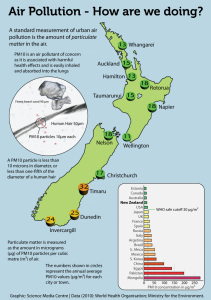Actual air pollution figures
 You may remember the story about Auckland air pollution being worse than Tokyo, due to data entry errors by the World Health Organization. The Science Media Centre has put out a new graphic showing actual air pollution levels around the country and around the world. [They also have the right spelling and location for Dunedin]
You may remember the story about Auckland air pollution being worse than Tokyo, due to data entry errors by the World Health Organization. The Science Media Centre has put out a new graphic showing actual air pollution levels around the country and around the world. [They also have the right spelling and location for Dunedin]
Levels are moderately high in the south of the South Island, due largely to the use of wood fires for heating. It’s worth noting that woodsmoke seems to have different health effects from the car and truck exhaust and factory emissions that dominate the fine-particle air pollution in other places with dirty air. Seattle, where I used to live, had a similar problem with wood smoke, and there has been a lot of study of the health effects. It looks as though wood smoke has harmful effects on the lungs, especially in triggering asthma attacks, but that it doesn’t have as much effect on the heart. Studies in Seattle find no relationship between heart disease and PM10, in contrast to cities where coal or diesel emissions are the main pollutant and associations are found consistently.
Windblown dust also seems to be less harmful: at the Biometric Society conference in Australia a couple of weeks ago there was a presentation on the 2009 Sydney dust storm, which raised PM10 levels to an amazing 15,000 micrograms per cubic meter. Even at these massive doses the researchers saw no increase in hospital admissions for cardiovascular disease, and a only modest 15% increase for asthma admissions and 25% increase for asthma hospital visits.
Thomas Lumley (@tslumley) is Professor of Biostatistics at the University of Auckland. His research interests include semiparametric models, survey sampling, statistical computing, foundations of statistics, and whatever methodological problems his medical collaborators come up with. He also blogs at Biased and Inefficient See all posts by Thomas Lumley »
More toxicology evidence on particulate woodsmoke pollution from typical seasoned log wood burned in local areas, less EPA hype and flaky PR media-wash epidemiology studies and PM10 fine particulate generalisations! H G Wells: Statistics can never be trusted without real evidence to back them up.
13 years ago
Jeremy,
There’s pretty reasonable toxicology and epidemiology on wood smoke as actually burnt in the Seattle area at least, and there hasn’t been any attempt by the US EPA to paper over the differences between wood smoke and other sources. In fact, the EPA has been very interested in trying to get source-specific estimates of health effects. This turns out to be hard: doing it from first principles via toxicology is difficult because we don’t understand which of the plausible mechanisms of harm are most important in humans, and doing it via epidemiology is difficult because of the difficulty in estimating source-specific exposures.
I haven’t (yet) had any contact with NZ researchers or regulators, so maybe the attitude is different here.
If you think the acute-effects epidemiology studies are are ‘flaky PR media-wash’ then you differ from nearly everyone who has made a serious effort to understand the evidence. Many statisticians and scientists initially feel this way, but end up changing their minds when better informed. I suggest the reports put out by the Health Effects Institute, which is a joint US EPA/industry initiative set up to get relatively impartial evidence.
The uncertainty in long-term effects is quite a lot bigger, but the uncertainty goes in both directions.
13 years ago